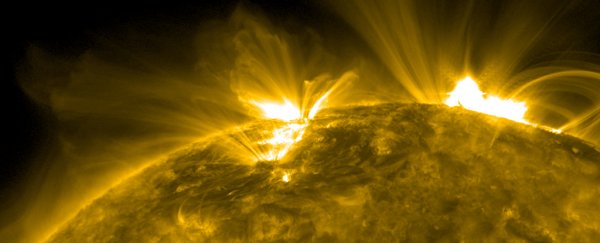For the first time, new research into solar winds and the 'space hurricanes' they create explains in detail how these bursts push plasma towards Earth – and how we might better protect the satellites and other technology we all rely on for modern living.
We're usually protected from the rays of charged particles pushed out by the Sun, thanks to Earth's magnetosphere or magnetic field boundary, but these shoots of energy can create huge vortices along that edge, pushing plasma into our magnetic shield.
That's thanks to a reaction known as Kelvin-Helmholtz (KH) instability, and it's this reaction and the knock-on effect on the vortices or space hurricanes that the team from Embry-Riddle Aeronautical University has been investigating.
You can see a Kelvin–Helmholtz reaction anywhere there is difference in speed and flow when different liquids or gases rub against each other – like wind blowing over the surface of the water. A similar kind of turbulence is happening at the limits of our atmosphere.
"The KH wave, or space hurricane, is one of the major ways that solar wind transports energy, mass and momentum into the magnetosphere," says one of the researchers, Katariina Nykyri from Embry-Riddle Aeronautical University.
"Fluctuations in solar wind affect how quickly the KH waves grow and how large they become."
Understanding that relationship is crucial if we are to protect ourselves against dangerous solar weather in the future. The vortices created can be up to 40,000 kilometres (24,855 miles) in size.
The stronger the solar winds, the larger these space hurricanes can become, report the researchers, pushing more plasma into our magnetosphere – a pattern which could give us a crucial advantage in predicting space weather and staying protected from it.
Even small fluctuations in the solar winds as they travel from the Sun to the Earth can have significant impacts on space hurricanes, according to readings taken by satellites and models produced by the team.
Satellites could eventually be trained to navigate more safely around the planet by looking for the tell-tale signs of these hurricanes, suggest the scientists.
With those satellites responsible for everything from GPS signals to radio communications, keeping them up and running in the face of major space weather events is the focus of a stack of recent research.
Earlier this month we saw the Sun blast out loops of plasma ten times the size of our planet, which eventually affected radio signals here on Earth.
Space hurricanes aren't exclusive to this planet either, and they can be set off in the magnetospheres of Jupiter, Saturn, and other planets as coronal mass ejections erupting from the Sun travel out through space.
The better we can understand the effects of these events on our planet's built-in protection system, the better we can get ready for them in the future.
"KH waves can alter the direction and properties of coronal mass ejections, which eventually affect near-Earth space weather," says Nykyri.
"For accurate space weather prediction, it is crucial to understand the detailed mechanisms that affect the growth and properties of space hurricanes."
The research has been published in the Journal of Geophysical Research - Space Physics.
